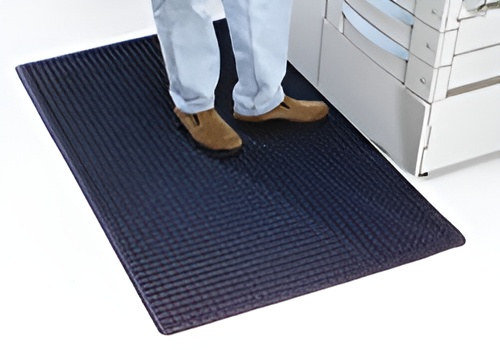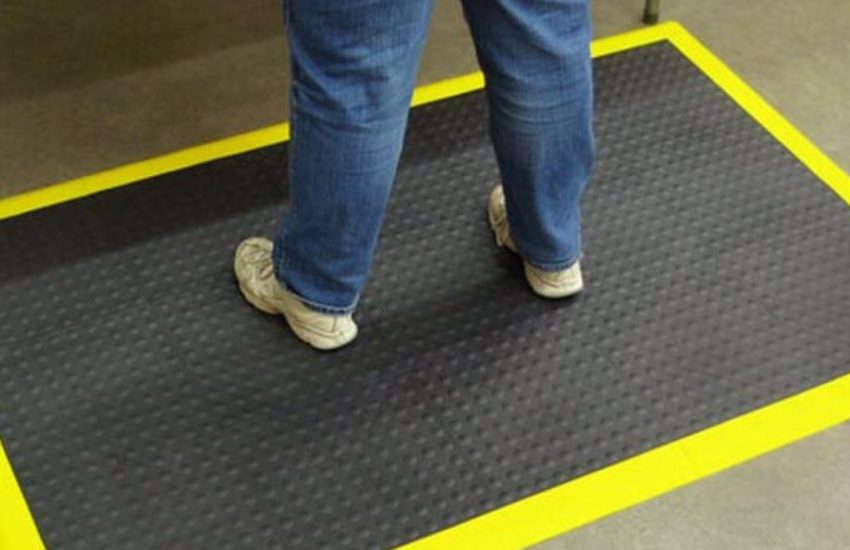Anti-fatigue mats are an important component of ergonomic commercial flooring options, which are designed to support health and wellness in everyday working and living environments. These mats are specially designed floor coverings that reduce physical strain caused by prolonged standing, especially on cement or other hard floors. Common in workplaces such as industrial facilities, kitchens, retail counters, and offices with standing desks, these mats provide cushioning that supports the feet, legs, and lower back.
Made from materials like rubber, foam, vinyl, or gel, anti-fatigue mats help improve comfort, boost circulation, and reduce the risk of musculoskeletal disorders associated with standing on hard surfaces such as concrete.

What Makes a Quality Anti-Fatigue Mat?
When selecting an anti-fatigue mat, consider the following:
- Material: Rubber and foam are often preferred for their resilience and ability to maintain their shape under pressure. Gel mats may offer extra comfort as well.
- Thickness and Density: Thicker mats generally offer better cushioning and support, but density matters too. A soft mat that compresses too much may not provide adequate support.
- Surface Texture: Textured surfaces help prevent slips and are easier to clean. Choose beveled edges to reduce tripping hazards.
- Durability: Commercial-grade mats are built to withstand heavy foot traffic and resist wear, chemicals, and moisture.
Material & Performance Overview
The material of an anti-fatigue mat plays a key role in its comfort, durability, and safety. Most mats are made from PVC (vinyl), rubber, polyurethane, or blends.
Vinyl Mats
PVC mats are the most budget-friendly option but also the least durable. They’re lightweight and offer basic cushioning for low-traffic, dry environments. However, PVC is prone to curling, cracking, and rippling—especially in areas with temperature fluctuations or moisture. This can pose tripping hazards over time.
Another drawback is slip resistance: many vinyl mats fall short when wet, increasing the risk of workplace slips. If choosing PVC, opt for mats with a molded surface bonded to the base, rather than glued layers, to prevent delamination and extend the mat’s usable life.
PVC mats are best suited for light-duty areas like retail counters or home workstations where conditions are controlled.
Rubber Mats
Rubber mats are a more durable and slip-resistant choice, well-suited for industrial or commercial settings. Two common types are SBR (styrene-butadiene rubber) and nitrile rubber.
-
SBR is cost-effective and provides good cushioning, but it doesn’t hold up well against oils or chemicals.
-
Nitrile rubber, on the other hand, excels in environments exposed to grease, oils, or harsh substances. It’s also highly slip-resistant and naturally resists microbial growth.
Nitrile mats are ideal for kitchens, factories, and auto shops. For added protection in hygiene-sensitive environments, look for anti-microbial treated nitrile mats, which offer extra defense against bacteria and product breakdown.
Rubber mats tend to be heavier and more durable than PVC, making them a smart long-term investment for high-use areas.
Enhancing Safety and Productivity
Addressing this problem can also improve safety and reduce injury from slipping, tripping and falling from tired, worn out legs. It can markedly improve an employee’s performance in the workplace simply by encouraging greater body comfort. It can have an impact on employee absences and overall productivity. Today’s mild foot problem might presage tomorrow’s major leg, back or neck issue. As energy levels improve in people, so does the quality and volume of what they can carry out.
Other fatigue contributing or assisting factors should also be considered, including regular shoe wear, stockings, standing posture, optional seating, footrest, standing tools, break time frequency improvements, existing flooring quality and its elasticity components, and any other behavioral, situational or environmental elements. However, despite other alleviating conditions or improvements, fatigue caused by both unconscious and outright discomfort from the stress of standing in uncomfortable conditions may still prove to be a problem.
Why Anti-Fatigue Mats Are Essential for Employee Health and Wellbeing
Standing for extended periods on hard floors can lead to chronic health issues, including:
- Foot and leg fatigue
- Joint pain and stiffness
- Poor circulation
- Lower back pain
- Long-term musculoskeletal problems
Anti-fatigue mats reduce these risks by providing cushioning and support, helping to alleviate the strain caused by standing for extended periods. This contributes significantly to employee health and well-being, reducing the long-term health consequences associated with standing on hard floors.
Work Environment Benefits of Anti-Fatigue Mats
Anti-fatigue mats are also widely recognized in ergonomics as a supportive tool for improving workplace conditions. Beyond safeguarding employee health, their benefits extend to:
- Lower absenteeism
- Increased productivity
- Fewer slips, trips, and falls (when mats are slip-resistant)
The Role of Anti-Fatigue Mats in Ergonomic Design
The use of such mats does not itself eliminate sore foot conditions, as ergonomics, stance, and footwear must also be considered, but the use of these mats can be an important part of addressing foot discomfort concerns that already exist. Anti-fatigue mats cushion each step taken while walking. This footstep buffering reduces the normally resulting foot problems. These specialty mats are manufactured from many different materials including vinyl, carpeting, and rubber. There are also wood-based mats. They are available in different colors and designs.
Anti-fatigue mats are recognized by the U.S. Department of Labor’s Occupational Safety and Health Administration or OSHA. Its list of guidelines, the Ergonomics for the Prevention of Musculoskeletal Disorders, has recently added an advisory that encourages their use by anyone standing for prolonged time periods. OSHA recognizes that these mats promote improved circulation and minimize fatigue in the legs and feet. The mats are also recognized as potentially reducing the risk of tripping and falling.
There are mats that specifically address slipping, but they are considered to be less effective with other problems. Mats that specifically discourage fatigue are shown to have considerable advantages over other recommended non-slip mat products. Anti-slip mats, an alternative safety floor covering, improve foot comfort and movement safety, but they also have a two-fold effect in contributing to skin surface soreness.
Popular Environments for Anti-Fatigue Mats
- Industrial Workplaces: In factories, assembly lines, and other industrial settings, workers often stand for long hours at stationary positions.
- Retail Stores: Employees in retail, particularly those at cash registers or service counters, stand for most of their shifts.
- Offices with Standing Desks: As standing desks become more popular in office environments, anti-fatigue mats are essential to provide comfort and reduce the physical strain associated with standing for prolonged periods while working on computers.
- Commercial Kitchens: Chefs, cooks, and kitchen staff typically stand for their entire shift, often on hard surfaces that can be harsh on the feet and joints.
- Home Workshops or Garages: Individuals who engage in hobbies or tasks that require standing, such as woodworking or car repairs, can benefit from anti-fatigue mats to make their activities more comfortable and to extend the duration they can work without discomfort.
Considerations When Choosing Between Anti-Slip and Anti-Fatigue Mats
While anti-slip mats are designed to prevent slipping hazards, it’s important to consider their suitability for prolonged standing. Some users have reported discomfort, such as heat buildup or friction-related irritation, when standing on certain anti-slip surfaces for extended periods. This can occur if the mat’s surface creates excessive grip inside the shoe, leading to resistance during natural foot movement. Over time, this friction could contribute to soreness or even blisters, particularly for individuals wearing thin-soled or poorly cushioned footwear.
Because of this, it’s essential to select a mat designed for the specific task. Anti-fatigue mats are engineered to provide both comfort and support, making them better suited for environments where standing is continuous or long-term. Many modern mats combine anti-fatigue cushioning with slip-resistant surfaces, offering both safety and ergonomic support.
Ultimately, improving the daily experience of those who stand and move across a floor space should be the goal. The right mat can make a meaningful difference in both comfort and well-being.
A Simple, Effective Solution for Employee Well-Being
Standing for long periods on hard floors can take a physical toll. Anti-fatigue mats offer a simple, effective way to reduce discomfort, support wellness, and improve productivity. When paired with good posture, appropriate footwear, and other ergonomic commercial flooring practices, they serve as a practical investment in both comfort and safety.
Improving the lives and conditions of people who work or spend time standing in a space starts with a small step—adding cushioning where it counts.
